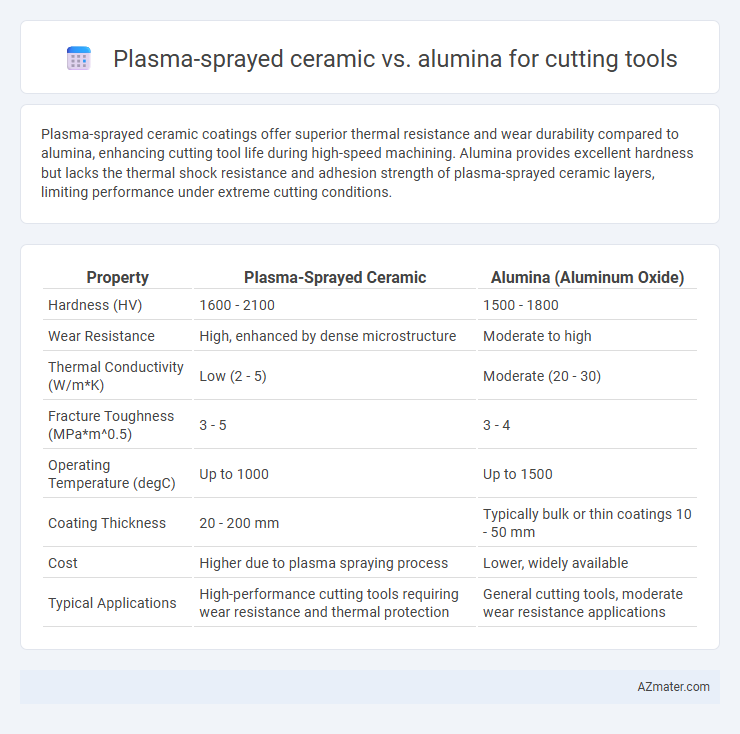Plasma-sprayed ceramic coatings offer superior thermal resistance and wear durability compared to alumina, enhancing cutting tool life during high-speed machining. Alumina provides excellent hardness but lacks the thermal shock resistance and adhesion strength of plasma-sprayed ceramic layers, limiting performance under extreme cutting conditions.
Table of Comparison
| Property | Plasma-Sprayed Ceramic | Alumina (Aluminum Oxide) |
|---|---|---|
| Hardness (HV) | 1600 - 2100 | 1500 - 1800 |
| Wear Resistance | High, enhanced by dense microstructure | Moderate to high |
| Thermal Conductivity (W/m*K) | Low (2 - 5) | Moderate (20 - 30) |
| Fracture Toughness (MPa*m^0.5) | 3 - 5 | 3 - 4 |
| Operating Temperature (degC) | Up to 1000 | Up to 1500 |
| Coating Thickness | 20 - 200 mm | Typically bulk or thin coatings 10 - 50 mm |
| Cost | Higher due to plasma spraying process | Lower, widely available |
| Typical Applications | High-performance cutting tools requiring wear resistance and thermal protection | General cutting tools, moderate wear resistance applications |
Introduction to Cutting Tool Materials
Cutting tool materials require exceptional hardness, thermal stability, and wear resistance to withstand high-speed machining conditions. Plasma-sprayed ceramic coatings offer enhanced thermal barrier properties and improved toughness over traditional alumina, which is widely favored for its hardness and chemical inertness. The choice between plasma-sprayed ceramic and alumina depends on machining applications where heat resistance and tool life are critical performance factors.
Overview of Plasma-Sprayed Ceramic Coatings
Plasma-sprayed ceramic coatings offer exceptional hardness and thermal resistance, making them ideal for enhancing cutting tool performance under high-speed and high-temperature conditions. These coatings consist of materials like zirconia or titania, deposited through a plasma spray process that creates a dense, adherent layer with superior wear and oxidation resistance compared to bulk alumina. The microstructure and thickness of plasma-sprayed ceramics contribute to improved tool life and cutting efficiency by minimizing friction and heat buildup during machining operations.
Properties and Structure of Alumina Cutting Tools
Alumina cutting tools exhibit high hardness, excellent wear resistance, and thermal stability due to their dense polycrystalline structure composed primarily of alpha-alumina (Al2O3) grains. Plasma-sprayed ceramic coatings, by contrast, feature a porous and layered microstructure that provides enhanced toughness and thermal barrier properties but lower hardness than bulk alumina substrates. The superior mechanical strength and chemical inertness of alumina make it ideal for high-speed machining, while plasma-sprayed coatings improve tool life by reducing heat transfer and surface degradation.
Wear Resistance Comparison: Plasma-Sprayed Ceramic vs Alumina
Plasma-sprayed ceramic coatings exhibit superior wear resistance compared to conventional alumina in cutting tool applications due to their enhanced microstructural density and thermal stability. The plasma spraying process enables the deposition of ceramic layers with improved adhesion and reduced porosity, resulting in prolonged tool life under high-temperature and abrasive conditions. Alumina, while widely used, typically shows higher wear rates and lower fracture toughness, making plasma-sprayed ceramics a more durable choice for demanding machining operations.
Thermal Stability and Performance Under High Temperatures
Plasma-sprayed ceramic coatings exhibit superior thermal stability compared to Alumina, maintaining structural integrity at temperatures exceeding 1200degC, which enhances cutting tool lifespan in high-temperature applications. Alumina, while providing excellent hardness and wear resistance, tends to degrade or crack under prolonged exposure to extreme heat, reducing cutting efficiency and tool durability. The thermal barrier and oxidation resistance offered by plasma-sprayed ceramics significantly improve performance under high-temperature machining conditions, optimizing tool reliability and cutting precision.
Hardness and Toughness: A Direct Comparison
Plasma-sprayed ceramic coatings exhibit significantly higher hardness, often exceeding 1500 HV, compared to alumina's typical hardness range of 1200-1400 HV, enhancing wear resistance in cutting tools. However, alumina demonstrates superior toughness, with fracture toughness values around 3-4 MPa*m^0.5, which reduces brittleness and improves resistance to chipping under high-impact cutting conditions. This direct comparison highlights that plasma-sprayed ceramics offer enhanced surface hardness for durability, while alumina provides better toughness for cutting tool longevity under mechanical stress.
Cutting Efficiency and Surface Finish Quality
Plasma-sprayed ceramic coatings on cutting tools provide superior cutting efficiency by enhancing wear resistance and thermal stability compared to traditional alumina coatings. The microstructural properties of plasma-sprayed ceramics reduce friction and improve chip flow, resulting in cleaner cuts and less tool degradation. Surface finish quality benefits from the homogeneous and dense ceramic layer, producing smoother workpiece surfaces and extended tool life relative to alumina-coated tools.
Cost-effectiveness and Industrial Applicability
Plasma-sprayed ceramic coatings offer superior thermal resistance and toughness compared to alumina, making them highly effective for cutting tools used in high-speed machining. Although plasma-sprayed ceramics involve higher initial costs, their extended tool life and reduced downtime result in better cost-effectiveness for large-scale industrial applications. Alumina remains a cost-efficient choice for less demanding operations due to its lower material and processing expenses, but it often falls short in performance under extreme cutting conditions.
Lifespan and Maintenance Requirements
Plasma-sprayed ceramic coatings provide cutting tools with superior wear resistance and thermal stability compared to conventional alumina coatings, significantly extending tool lifespan in high-speed machining applications. These coatings exhibit enhanced adhesion and toughness, reducing the frequency of maintenance and re-coating processes required for alumina-coated tools. As a result, plasma-sprayed ceramic tools offer improved durability and lower overall maintenance costs, making them ideal for demanding industrial cutting operations.
Summary: Selecting the Optimal Cutting Tool Material
Plasma-sprayed ceramic coatings offer superior wear resistance and thermal stability compared to conventional alumina cutting tools, making them ideal for high-speed machining applications with elevated temperatures. Alumina tools provide excellent hardness and chemical inertness but may suffer from brittleness under impact or cyclic loads. Choosing between plasma-sprayed ceramic and alumina depends on the specific machining conditions, where plasma-sprayed ceramics excel in durability and heat dissipation for prolonged tool life.

Infographic: Plasma-sprayed ceramic vs Alumina for Cutting tool
 azmater.com
azmater.com